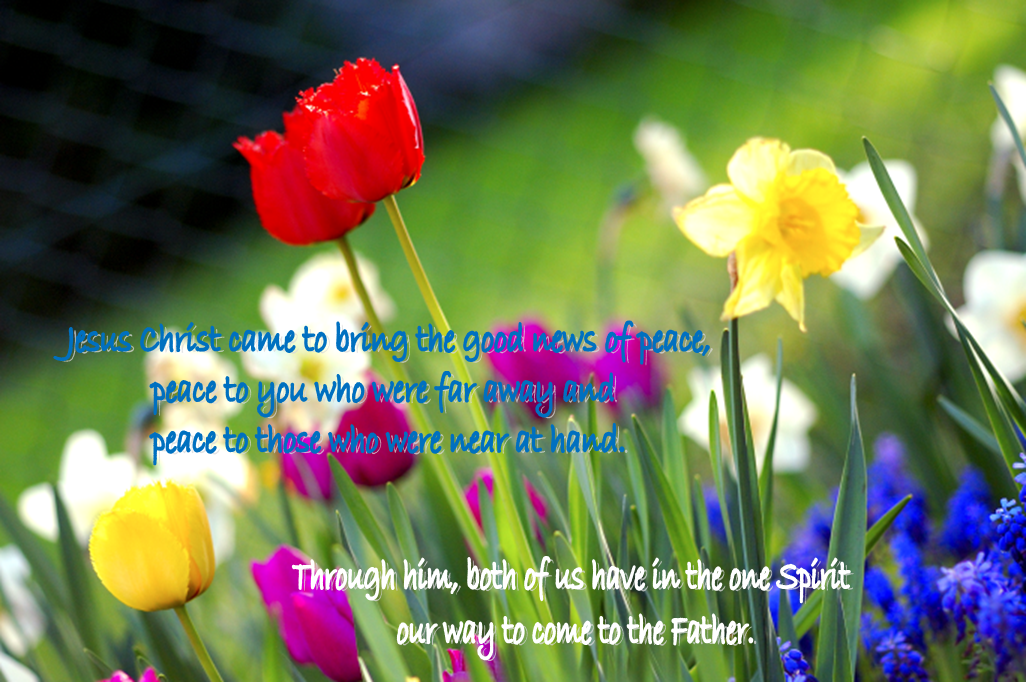|
22 July 2012
Jesus Christ comes to unite Jews and Gentiles as One in Him - Extracted from the letter of Saint Paul to the Ephesians, Chapter 2:13-18
In Christ Jesus, you that used to be so far apart from us have been brought very close, by the blood of Christ.
For he is the peace between us, and has made the two into one and broken down the barrier which used to keep them apart, actually destroying in his own person the hostility caused by the rules and decrees of the Law.
This was to create one single New Man in himself out of the two of them and by restoring peace through the cross, to unite them both in a single Body and reconcile them with God: in his own person he killed the hostility.
Later he came to bring the good news of peace, peace to you who were far away and peace to those who were near at hand.
Through him, both of us have in the one Spirit our way to come to the Father.
Accredited Interpretation by the Church:
In elevated language and perhaps drawing upon hymnal material, the author takes up the theme of peace (2:14, 15, 17a, b) in order to show the unity of the relationship of Gentiles and Jews in Christ.
Christ who is our peace has also effected peace by uniting Jew and Gentile. He did this by breaking down the barrier wall of enmity separating them, that is through his death he abolished the law with its commands and prescriptions as a divisive factor.
The purpose of doing so was to create one new being in himself from the two groups, Jews and Gentiles. In this way, through the cross, he reconciled both to God in one body, having put the enmity between them to death.
The one body is a pregnant term referring both to Christ’s physical body which was put to death and to his body, the church, which consists of Jews and Gentiles. Therefore, through his coming and by his action, he proclaimed peace to both – to the Jews who were near and to the Gentiles who were far away (2:13). As a result, both have access to the Father in one Spirit (4:4); the Spirit is at work in the body of Christ, is active in the Church. 22 July 2012 |

|
28 July 2012
Jesus Christ our Teacher & Good Shepherd took pity on them - Extracted from the holy Gospel according to Mark, Chapter 6:30-34
The apostles rejoined Jesus and told him all they had done and taught.
Then he said to them, ‘You must come away to some lonely place all by yourselves and rest for a while’; for there were so many coming and going that the apostles had no time even to eat. So they went off in a boat to a lonely place where they could be by themselves.
But people saw them going, and many could guess where; and from every town they all hurried to the place on foot and reached it before them.
So as he stepped ashore he saw a large crowd; and he took pity on them because they were like sheep without a shepherd, and he set himself to teach them at some length.
Extracted in part the Homily of Blessed Pope John Paul II on Good Shepherd Sunday 25 April 1999
1. “I am the Good Shepherd ...; I know my sheep and my sheep know me” (Gospel Acclamation).
As we continue our journey through the liturgical season of Easter, today we celebrate what is traditionally called “Good Shepherd Sunday”. Jesus applies to himself this image (cf. John 10:6), rooted in the Old Testament and very dear to Christian tradition. Christ is the Good Shepherd who, by dying on the Cross, lays down his life for his sheep. Thus a profound communion is established between the Good Shepherd and his flock. Jesus, according to the Evangelist, “calls his own sheep by name and leads them out ... and the sheep follow him, for they know his voice” (John 10:3-4). Sheep and Shepherd are united by long familiarity, real knowledge and mutual attachment: he takes care of them; they trust him and follow him faithfully.
How comforting, then, are the words we have just repeated in the Responsorial Psalm: “The Lord is my shepherd; there is nothing I shall want” (John 10:3-4).
2. Continuing a beautiful custom, for several years I have had the joy of ordaining new priests precisely on Good Shepherd Sunday. Today there are 31 of them. They will dedicate their enthusiasm and fresh energies to the service of the community of Rome and the universal Church. ...
3. Dear ordinands, through the ancient and evocative sacramental rite of the laying-on of hands and the prayer of consecration, you will become priests in order to be servants of the Christian people in a new and more profound way, in the image of the Good Shepherd. You will share in Christ's own mission, scattering freely the seed of God's word. The Lord has called you to be ministers of his mercy and dispensers of his mysteries.
The Eucharist, the source and summit of the Christian life, will be the crystal clear spring that will constantly replenish your priestly spirituality. You will be able to draw from it the inspiration for your daily ministry, apostolic zeal for the work of evangelization and spiritual consolation in the inevitable moments of difficulty and inner struggle. By standing at the altar where the sacrifice of the Cross is renewed, you will increasingly discover the wealth of Christ's love and learn to express it in your life. |
|
4. Dear friends, it is very significant that you are receiving the sacrament of Holy Orders on this Good Shepherd Sunday, when we are celebrating the World Day of Prayer for Vocations. Indeed, throughout history Christ's mission is extended through the work of the Shepherds to whom he entrusts the care of his flock. As he did with the first disciples, Jesus continues to choose new co-workers to care for his flock through the ministry of the word, the sacraments and the service of charity. A vocation to the priesthood is a great gift and a great mystery. A gift, first of all, of divine benevolence, because it is the fruit of grace. It is also a mystery because a vocation is rooted in the depths of conscience and of human freedom. It starts with a dialogue of love, which day after day moulds the priest's personality through a formation process begun in the family, continued in the seminary and extended throughout his life. Only through this uninterrupted ascetical and pastoral journey can the priest become a living icon of Jesus, the Good Shepherd, who gives himself for the flock entrusted to his care.
The words I will address to you in a little while when I give you the offerings for the Eucharistic sacrifice echo in my mind: “Imitate the mystery you celebrate”. Yes, dear ordinands, this mystery you dispense is really Christ himself, who through the communication of the Holy Spirit is the source of holiness and a ceaseless call to sanctification. Imitate this mystery: imitate Christ, be Christ! May each of you be able to say with St Paul: “It is no longer I who live, but Christ who lives in me” (Galatians 2:20).
28 July 2012 |

